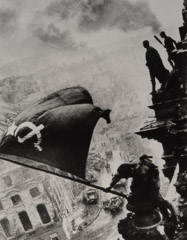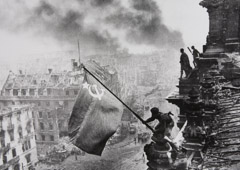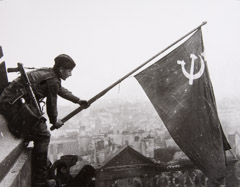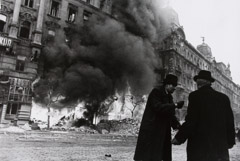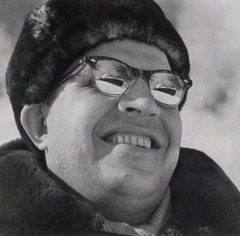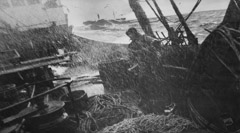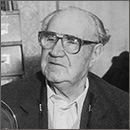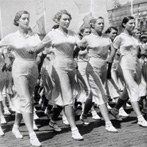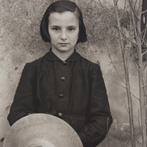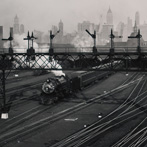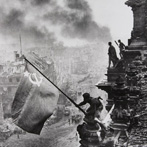Yevgeny Khaldei
Yevgeny Khaldei (1917-1997)
It is symbolically fitting that Yevgeni Khaldei, who became one of the most significant photojournalists of the 20th-century, was born in the same year as the Soviet Revolution. On March 10, 1917, Khaldei was born into a Jewish family, the youngest of six children in Donbass, a Ukrainian steel town. He was introduced to the horrors of the Russian Revolution on March 13, 1918 during a pogrom, when a bullet fired by an anti-Jewish gunman passed through Khaldei’s side and into his mother, killing her.
His childhood was about survival. He subsisted on grass during a great famine that killed many of his countrymen. At eleven, he worked cleaning steam engines in exchange for food. At the age of twelve he left school and began to work in a steel factory. This is where his passion for photography was realized. He created a crude box camera with a lens from his dead Grandmother’s eye-glasses and experimented by taking portraits of his sisters. At the age of fifteen his photographs started to appear in his local paper Socialist Donbass. Yevgeni Khaldei portrayed the local miners and steelworkers as pioneers building the Great Utopia.
By the time he was eighteen years old, he had landed a job as a staff photographer at the Tass news agency based in Moscow. When the German troops invaded the USSR, Khaldei was commissioned as a lieutenant in the Soviet army. He was sent out to photograph the Second World War carrying a camera, a backpack, chemicals to develop film, and a black leather coat. He covered all 1,481 days of the War between USSR and Germany as a correspondent for the Tass News Agency and much of this work was published in Pravda.
The images that Khaldei took during the War were later compiled to create the album From Murmansk to Berlin, a chronicle of the Soviet involvement in the War. At the outbreak of the Second World War Khaldei was sent to the Arctic city of Murmansk. He was stationed with a group of British pilots who were sent to protect the Arctic convoys.
In April of 1945, the Soviet reached Berlin. Khaldei planned to photograph the capture of the city as it unfolded. When he realized that there were no Soviet flags in the city, he hopped on a plane to Moscow and searched throughout the day for a flag. As he entered a shop, he noticed some red tablecloths used for formal events. He borrowed three of these tablecloths from a reluctant shop worker named Grisha Lubinskii. Khaldei brought them to his uncle, a tailor, who then stayed up all night to sew on the hammer and sickle and yellow star.
Rushing back to Berlin he raised the first make shift flag over the Great German Eagle at the Tempelhof Airport on April 28. On May 2, Khaldei reached the Brandenburg Gate and witnessed a group of Russian troops being told that Hitler was dead. Khaldei immediately climbed the staircase of the gate and placed the second tablecloth-flag at the top with the bronze horses. Khaldei was determined to place the final Red Army flag at the top of the Reichstag. When he reached the burnt out structure, fighting was still going on in the basement. Khaldei and three comrades ascended to the roof of the Reichstag, which was slippery with blood from the fierce fighting just hours before. Khaldei then snapped one the most dramatic images of the century as the Russian soldiers raised the Soviet flag over the Reichstag.
At the War’s end Khaldei was at the Potsdam conference to photograph the victorious leaders and sent to Manchuria for the last days of the Soviet Army’s campaign against the Japanese. In the fall of 1945 he documented the war crimes trial in Nuremberg where many Nazis were convicted. After the war’s end Khaldei made a very modest living working in film labs and continuing to photograph for Russian publications. He died in Moscow on October 6th, 1997 at the age of 80.
Born: March 10, 1917, Ukraine, Donbass
Died: October 6, 1997, Moscow
The work of Yevgeny Khaldei is featured in these exhibitions.
(Select the image to view the exhibition page)
The work of Yevgeny Khaldei is featured in these Theme Collections.
(Select the image to view the theme page)
Yevgeny Khaldei "Badass War Hero"
In a post on the comedy web site Cracked.com, the Russian photographer Yevgeny Khaldei was cited as one of The 5 Most Badass War Heroes Who Never Held a Weapon. Khaldei came in at the #2 position on the list of 5.
Follow the link to see the entire article and read the colorful account of Khaldei’s life. A more complete biography of Khaldei’s life can be found in the Artist Section of our web site, including a gallery of images by Khaldei.
Our exhibition, Photography as Propaganda – Politics and the Utopian Dream, featured eight photographs by Khaldei. The 70+ print exhibition included 3 variation of his most famous image: Raising The Hammer & Sickle over the Reichstag, May of 1945.

